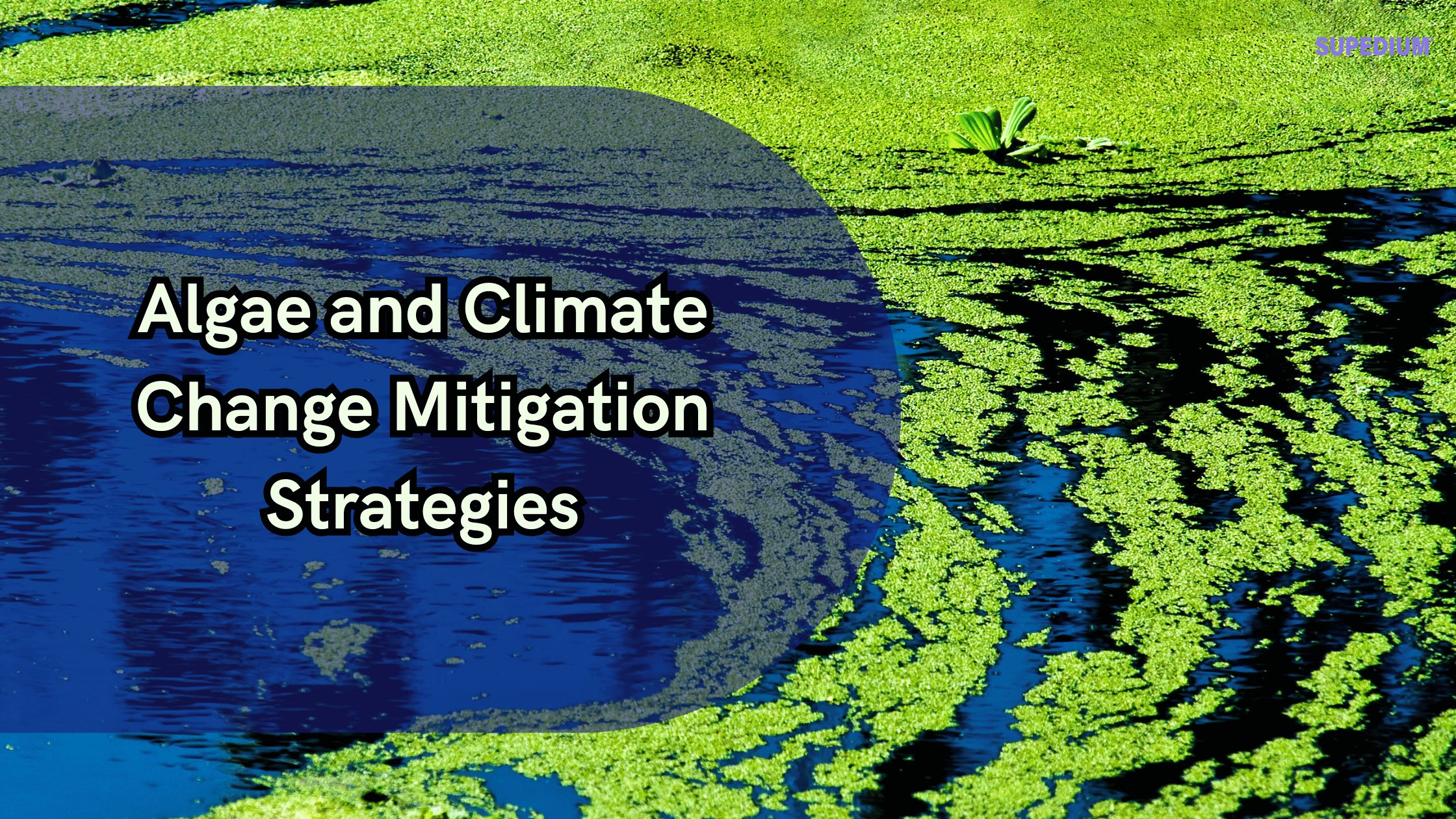Table of Contents
![]()
Climate change is one of the most pressing challenges of our time, impacting ecosystems, economies, and human livelihoods. In response, innovative strategies are emerging to address this global crisis. Among these, algae have garnered significant attention as a potential solution for mitigating climate change. Algae, through their unique biological processes, offer promising avenues for carbon capture, renewable energy production, and climate resilience. This article explores algae-based strategies for climate change mitigation, examining their potential, benefits, challenges, and future prospects.
The Science of Algae and Climate Change
Understanding Algae’s Role in Carbon Capture
Algae play a vital role in the Earth’s carbon cycle. Through photosynthesis, algae absorb carbon dioxide (CO2) from the atmosphere and convert it into organic matter. This process makes algae one of the most efficient organisms for carbon sequestration. Whether in oceans, freshwater systems, or terrestrial environments, algae capture significant amounts of CO2, helping to regulate the concentration of greenhouse gases in the atmosphere.
Types of Algae Involved in Climate Mitigation
There are various types of algae that contribute to climate change mitigation:
- Microalgae: These microscopic organisms are among the most efficient at photosynthesis, absorbing CO2 and producing oxygen. Microalgae are widely studied for their potential in carbon capture and biofuel production.
- Macroalgae: These larger algae, such as seaweed, play a critical role in coastal ecosystems and can also contribute to carbon sequestration.
- Phytoplankton: Tiny marine organisms that form the base of the aquatic food chain. Phytoplankton also absorb CO2 during photosynthesis, significantly contributing to global carbon cycles.
These types of algae, whether individually or together, offer a robust method of tackling climate change by sequestering carbon and reducing atmospheric CO2 levels.
Algae-Based Carbon Sequestration
How Algae Capture Carbon Dioxide
Algae absorb CO2 from the atmosphere during photosynthesis. This process, which involves converting sunlight, CO2, and water into oxygen and organic matter, is highly effective at reducing greenhouse gases in the air. By fixing carbon in their cells, algae contribute to the global effort to lower atmospheric CO2 concentrations.
Methods of Utilizing Algae for Carbon Sequestration
- Ocean-Based Carbon Sequestration: The oceans are a key reservoir for carbon storage, and algae play a critical role in this process. Large-scale cultivation of algae, particularly macroalgae like kelp, could enhance the ocean’s natural ability to sequester carbon. By increasing the growth of algae in coastal and open ocean areas, we could potentially capture large amounts of CO2.
- Algae-Based Biofuels as a Carbon-Neutral Energy Source: Algae can be converted into biofuels, such as biodiesel and bioethanol. These biofuels are considered carbon-neutral because the CO2 released during their combustion is roughly equivalent to the CO2 absorbed by algae during growth. This process helps reduce reliance on fossil fuels and lowers overall greenhouse gas emissions.
- Algae in Soil Carbon Storage: Algae-based biochar (a form of charcoal produced by heating algae in the absence of oxygen) can be used to enhance soil fertility and store carbon. This biochar retains carbon in a stable form, reducing its release into the atmosphere and contributing to long-term carbon storage in soils.
Effectiveness of Algae in Long-Term Carbon Storage
Algae-based carbon sequestration offers both short-term and long-term benefits. While the immediate carbon capture from algae’s growth is significant, ensuring that this carbon remains sequestered for extended periods is crucial. Methods like algae-based biochar and deep-sea storage of algae biomass are promising for creating lasting carbon sinks.
Algae as a Source of Renewable Energy
Algae-Based Biofuels
One of the most promising applications of algae in climate change mitigation is the production of biofuels. Algae can produce a variety of biofuels, including:
- Biodiesel: Algae produce lipids (fats), which can be converted into biodiesel. This biofuel can replace petroleum-based diesel, reducing CO2 emissions.
- Bioethanol: Algae can also produce ethanol, a biofuel typically made from crops like corn. Algae-based ethanol has the potential to be more efficient and environmentally friendly than traditional ethanol.
- Biogas: Algae biomass can be converted into methane, which can be used as a renewable energy source.
Algae’s Potential to Reduce Reliance on Fossil Fuels
Algae biofuels offer a sustainable alternative to fossil fuels. Unlike fossil fuels, which release sequestered carbon when burned, algae biofuels are part of a closed carbon cycle. The CO2 absorbed by algae during growth is released back into the atmosphere when the biofuels are burned, but no additional carbon is added to the cycle. This makes algae biofuels a critical tool in reducing the carbon footprint of energy production.
Challenges and Limitations of Algae-Based Biofuels
While algae biofuels offer significant potential, there are challenges that must be addressed before they can be widely implemented:
- Economic Feasibility: Algae biofuels are currently more expensive to produce than fossil fuels, primarily due to high cultivation, harvesting, and processing costs.
- Technological Barriers: Scaling up algae biofuel production requires advanced technologies, such as efficient photobioreactors and large-scale harvesting techniques, which are still in development.
Despite these challenges, continued research and technological advancements are likely to improve the economic and practical viability of algae-based biofuels in the future.
Algae for Climate Resilient Agriculture
Algae as a Natural Fertilizer
Algae have been used for centuries as a natural fertilizer, particularly in coastal farming regions. Algae-based fertilizers contain essential nutrients that improve soil health and enhance crop productivity. They can also help reduce the need for synthetic fertilizers, which are energy-intensive to produce and can contribute to environmental pollution.
Algae in Agroecological Practices
Algae are increasingly being incorporated into sustainable farming practices. For example, algae-based products can be used to increase crop resilience to extreme weather conditions, such as droughts or floods, which are becoming more frequent due to climate change. Algae’s rich nutrient content and growth-promoting properties make them an ideal supplement for organic farming and agroecology.
Algae for Reducing Greenhouse Gas Emissions in Agriculture
Algae can also help reduce greenhouse gas emissions in the agricultural sector. For example, algae-based feeds for livestock can significantly lower methane emissions, a potent greenhouse gas produced by ruminant animals. This is achieved by adding algae to animal feed, which helps reduce the formation of methane in the digestive systems of cows and other livestock.
Algae in Climate Change Adaptation
Coastal Protection and Habitat Restoration
Algae play an essential role in protecting coastal ecosystems from the impacts of climate change. Macroalgae, such as kelp, create underwater forests that provide shelter and food for marine life, prevent coastal erosion, and reduce the impact of storm surges. Restoring and expanding these algae habitats can significantly enhance coastal resilience to climate change.
Algae as a Tool for Ecosystem-Based Adaptation
In addition to their role in coastal protection, algae contribute to biodiversity conservation by providing habitats for various marine species. Healthy algal ecosystems are vital for maintaining the balance of marine food webs and supporting biodiversity, which is crucial for climate change adaptation.
Algae in Water Quality Improvement
Algae also play a critical role in improving water quality. They can filter pollutants, including heavy metals and excess nutrients, from water bodies, thus enhancing the health of aquatic ecosystems. Clean water is essential for supporting both biodiversity and human livelihoods, and algae-based solutions can contribute to improving water quality as part of climate adaptation efforts.
Policy and Economic Perspectives
Government Support and Funding for Algae-Based Climate Solutions
Government policies and funding are crucial for advancing algae-based climate change mitigation strategies. Policies that promote algae research, biofuel production, and carbon capture can accelerate the development and deployment of algae-based solutions. Additionally, incentives for algae-based carbon capture projects and renewable energy technologies will be essential in scaling these efforts.
Economic Viability and Market Potential of Algae-Based Products
The algae-based industry is growing rapidly, with applications in biofuels, fertilizers, food, and pharmaceuticals. As the demand for sustainable products increases, the economic potential of algae will expand. Job creation in algae-based industries will also contribute to economic growth and help transition economies toward more sustainable practices.
Global Collaboration in Algae-Based Climate Strategies
Algae-based climate solutions will benefit from international collaboration. Researchers, governments, and businesses worldwide are working together to unlock the full potential of algae for climate change mitigation. Sharing knowledge and resources will help accelerate progress and make algae-based solutions more accessible globally.
Challenges and Limitations
Technical Challenges in Algae-Based Climate Mitigation
Despite the significant potential of algae, several technical challenges remain. These include the efficient cultivation of algae on a large scale, harvesting algae from the ocean or land-based systems, and developing cost-effective processing methods. Overcoming these challenges will require continued investment in research and innovation.
Environmental Concerns of Large-Scale Algae Cultivation
Large-scale algae cultivation, especially in coastal areas, can have environmental impacts. Potential risks include nutrient imbalances that could lead to harmful algal blooms and disrupt local ecosystems. Ensuring that algae farming is carried out sustainably is critical to minimizing these risks.
Economic and Logistical Challenges
The economic feasibility of algae-based climate solutions depends on reducing production costs and improving the efficiency of algae cultivation systems. Additionally, building the infrastructure for large-scale algae farming, processing, and distribution remains a significant challenge.
Future Prospects and Innovations
Emerging Algae Technologies for Climate Change Mitigation
Innovative algae technologies are emerging that promise to address some of the current challenges. Photobioreactors, for example, allow for the controlled cultivation of algae in closed systems, increasing efficiency and reducing environmental impacts. Other innovations, such as algae-based carbon capture systems and biofuel production methods, are also on the horizon.
The Role of Algae in a Sustainable Circular Economy
Algae have the potential to play a key role in a circular economy, where waste is minimized, and resources are reused. Algae can be used in waste-to-energy systems, converting organic waste into biofuels or other valuable products. Additionally, algae’s potential in creating biodegradable plastics and other sustainable materials offers opportunities for reducing reliance on fossil-based products.
The Promise of Algae in Achieving Climate Goals
Algae’s potential to capture carbon, provide renewable energy, and contribute to sustainable agriculture makes it a critical tool in achieving global climate goals. By integrating algae-based solutions into national and international climate strategies, we can accelerate efforts to mitigate and adapt to climate change.
Conclusion
Algae hold significant promise as a natural solution for mitigating climate change. From carbon sequestration and renewable energy production to enhancing agricultural sustainability and protecting coastal ecosystems, algae offer diverse and impactful strategies. However, overcoming technical, economic, and environmental challenges will be key to unlocking their full potential. With continued research, innovation, and global collaboration, algae-based solutions can play a pivotal role in the fight against climate change.
Share This





Be the first to comment